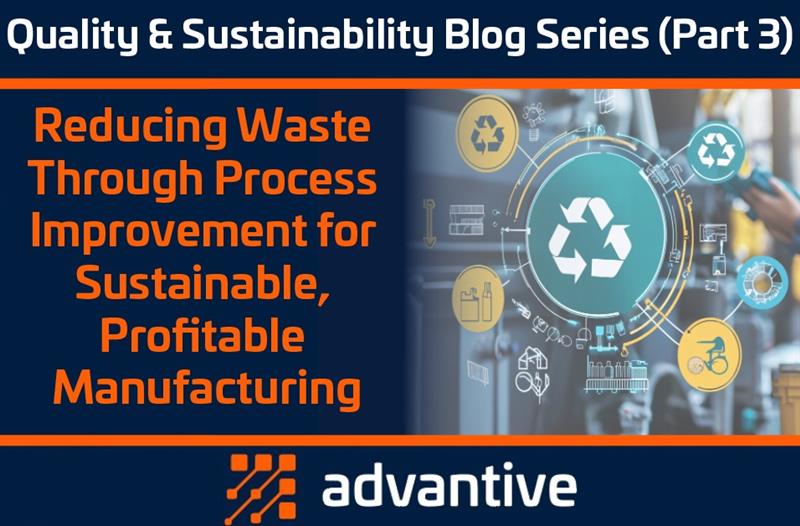
Welcome back to part 3 of our Quality & Sustainability blog series! Last week, we explored four practical ways to connect quality with sustainability: waste reduction, energy efficiency, real-time monitoring, and ISO 9001 & 14001 integration. In this blog, we’re focusing specifically on waste reduction, diving into its impact on quality management and sustainable production practices.
Let’s explore how understanding process control, managing variation, and targeting manufacturing tolerances can minimize waste while maintaining product quality.
Waste Reduction Through Process Improvement
Waste reduction is central to both quality management and sustainability. It tackles inefficiencies like scrap and giveaway. Let’s break these down.
Scrap and the Cost of Reactivity
Discussions about waste often begin with scrap, the most tangible form of waste.
Bad Product
For many, quality management simply means inspecting the finished products, tossing those that fail to meet specifications or reworking the defective products. This reactive approach – waiting until production is complete before addressing issues – is costly and inefficient. As the saying goes, “If you don’t have time to build it right, where are you going to find the time to build it again?”
Out-of-Control Processes
A better strategy involves shifting focus upstream, examining the production process itself. It is essential to understand whether your process is capable of producing good-quality products. This proactive mindset transforms quality management into a dialogue with your processes. You can monitor key characteristics as they emerge on the production line, rather than waiting for the finished product.
Let’s use being a parent as an example. Understanding your child’s personality requires observing their interactions and signals. You want to open a conversation and listen to them. If you’re trying to understand the dialogue with your child, you need to hear what’s being told to you, not just vocally, but seeing what the signals – how they interact with their friends, what they’re doing, etc. – are saying as well. If something is wrong, you need to provide guidance in a different direction.
Similarly, understanding your manufacturing process involves paying attention to its behaviors and outputs. You need to watch for things that need correction or make an adjustment to guide the process towards a different outcome. If you understand your processes by having an open dialogue – listening, hearing, and paying attention to the signals – you’ll be able to respond proactively to changes when they show up.
Understanding Issues
Now to understand the issues, you need to collect and analyze the data, record how you address the issues, and evaluate whether those solutions work. Even when corrections fail, the lessons learned are invaluable for future improvements.
Timed Data Collection
Timed data collection is extremely valuable and should be done regularly. It should be an honest measure of your process’s performance and a record of how you expect it to behave. The historical data can reveal cyclical trends and shifts, enabling proactive adjustments that can reduce scrap and improve efficiency.
Mislabeled Products
Waste reduction extends to issues like mislabeled products, which can render perfectly good products as unsellable. Say we’re making diet cola, and we put it into cans labeled regular cola. This is one of the worst-case scenarios, where you have perfectly good product that you’re forced to toss because the labels are painted onto the cans of soda. These errors result in unnecessary waste and lost profits.
Every time you start a production run, you want to make sure that you’re checking the label before putting it onto a bunch of product. You can automate this process with a software system, or if you’re manually capturing the process, then you have to remember to do it.
Managing Giveaway
An often-overlooked aspect of waste reduction is managing giveaway, particularly through overfill. From the customer’s perspective, receiving a slightly overfilled container might seem like an unexpected bonus. However, overfill represents a direct hit to efficiency, profitability, and sustainability for manufacturers. Each gram, ounce, or milliliter given away adds up over time, increasing material costs and cutting into margins.
The Solution to Overfill
The solution lies in having a dialogue with your processes to monitor their performance for out-of-control factors and stability and variation.
Let’s consider the example of filling operations. If your process variation is predictable and controlled tightly, you may be tempted to aim for the middle of your tolerance range to ensure compliance and avoid underfilling. After all, underfilling can lead to significant fines or regulatory action.
Instead, you can take advantage of your precise data collection and firm grasp on process variation to safely adjust the target. Rather than aiming right down the middle, you can aim a little below the middle of your tolerance, as long as you make sure your variation won’t overlap underfill. This approach allows you to avoid underfill but reduce the amount of product given away. It also requires confidence in your process stability, which you can ensure through tools like SPC.
Overfill as a Sustainability Challenge
The other aspect of giveaway and overfill from a sustainability standpoint relates to moving unnecessary weight. Similar to the example above, if every container is overfilled by 1%, the additional weight adds up across the production line. Over a year, this could mean transporting hundreds or even thousands of extra pounds of product, increasing fuel consumption and transportation costs.
If you target lower on your tolerance range, you can not only improve your profitability but also advance your sustainability goals.
Come Back Next Time
Waste reduction is a crucial step toward improving sustainability in your manufacturing operations. Energy efficiency plays an equally significant role. In our next blog, we’ll shift our focus to the strategies manufacturers can use to optimize energy consumption, from refining process setups to improving machine performance.
Stay tuned to learn how these measures can reduce costs and environmental impact, driving your operations toward a more sustainable, profitable, and efficient future.